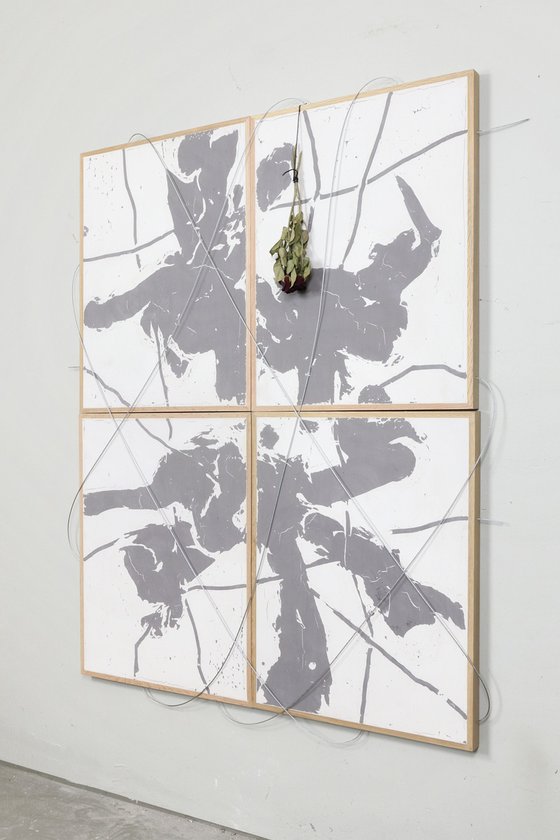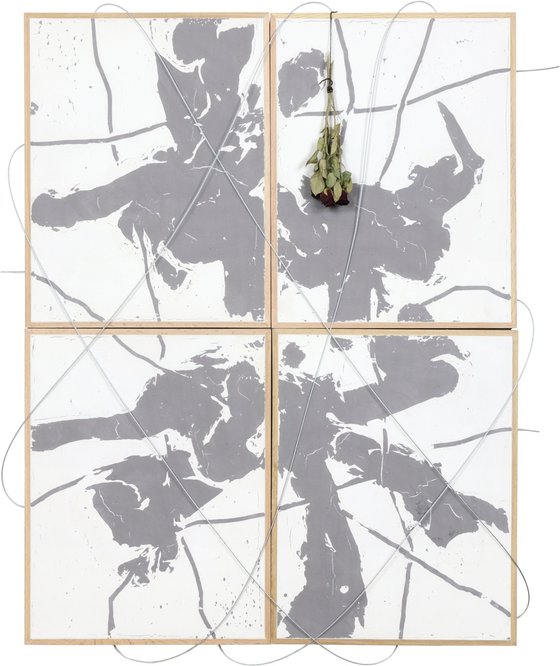- By medium
- By subject
- By budget
- Sales
- Gift cards
- Discover all art
- Artists
- Editors’ picks
- Ideas
Original artwork description:
128x168 cm (each panel 64x84cm) | Filler, oak panels, steel wire, dried roses
My works are cast in oak panels using standard wall filler (not cement).
In this work, I made two drawings simultaneously in wet filler while the panels were placed on the floor: one with my feet wearing plastic clogs and the other with a long stick. The finished work connects the drawing with pieces of fuel hose attached to the sides of the panels. Three dried roses hang from the top edge.
While doing this work, I've been thinking about the subject's relationship to work – to its function in the economic structure as labour. The usual view is that the struggle for power takes place along a dividing line, with the workers on one side and the employer on the other. However, the employer's function is more integrated into his subject. At the same time, there is a split, or alienation, in the worker between his function in the workplace and his experience as a subject. The worker stands at the intersection of the power struggle, with the employer on one side and his position as a subject on the other. The struggle for economic power in society thus takes place within the subject as worker, not between worker and employer.
I also wanted to explore the duality of the worker's loyalty and function. On one hand, there is a loyalty to the needs of the workplace, which is often at odds with the worker's personal needs. This conflict underscores the interdependence and incompatibility of these two aspects. The worker's function, which the employer can exploit, also holds a liberating force concerning other workers. This duality suggests that only through unity can the inherent alienation within each worker be overcome.
Materials used:
Filler, oak panels, fuel hose, dried roses
Tags:
#abstract #painting #minimalism #filler #oak frame#517 Sabotage-Steel And Roses (2024) Painting
by Johan Söderström
1 Artist Reviews
£4,364.07
- Painting on Panel / Board / MDF
- One of a kind artwork
- Size: 128 x 168 x 5cm (framed)
- Framed and ready to hang
- Signed on the back
- Style: Expressive and gestural
- Subject: Abstract and non-figurative
Loading
Original artwork description
128x168 cm (each panel 64x84cm) | Filler, oak panels, steel wire, dried roses
My works are cast in oak panels using standard wall filler (not cement).
In this work, I made two drawings simultaneously in wet filler while the panels were placed on the floor: one with my feet wearing plastic clogs and the other with a long stick. The finished work connects the drawing with pieces of fuel hose attached to the sides of the panels. Three dried roses hang from the top edge.
While doing this work, I've been thinking about the subject's relationship to work – to its function in the economic structure as labour. The usual view is that the struggle for power takes place along a dividing line, with the workers on one side and the employer on the other. However, the employer's function is more integrated into his subject. At the same time, there is a split, or alienation, in the worker between his function in the workplace and his experience as a subject. The worker stands at the intersection of the power struggle, with the employer on one side and his position as a subject on the other. The struggle for economic power in society thus takes place within the subject as worker, not between worker and employer.
I also wanted to explore the duality of the worker's loyalty and function. On one hand, there is a loyalty to the needs of the workplace, which is often at odds with the worker's personal needs. This conflict underscores the interdependence and incompatibility of these two aspects. The worker's function, which the employer can exploit, also holds a liberating force concerning other workers. This duality suggests that only through unity can the inherent alienation within each worker be overcome.
Materials used:
Filler, oak panels, fuel hose, dried roses
Tags:
#abstract #painting #minimalism #filler #oak frame14 day money back guaranteeLearn more












